Maps can be charmingly deceptive—not just because they can give a false sense of control but also because they can masquerade as vehicles of transparency. They are tricky, slippery things to create, especially in a city such as Karachi where much of life is lived undocumented.
Our story on Karachi’s water crisis this summer demanded a map and I was asked to crunch the data and make one. Luckily, we had several sets of data to work with. The most important source was the ‘Progress Report’ prepared by the Karachi Water & Sewage Board for the Supreme Court on the action it had taken against illegal water hydrants from January 26 to March 5. It basically contains lists of the FIRs registered against men running illegal hydrants.
I began the job by recreating on Google Maps the water trunk mains that run throughout Karachi with the help of a high-resolution GIS image file provided by the KW&SB mapping cell. These trunk or bulk mains are usually 33-inch lines that supply water to a smaller network of distribution lines that reach homes and businesses. They are the blue lines you see on the map we made. I then added blue dots for the KW&SB’s official hydrants based on a list they gave us. (Our map does not show the entire spidery network of all water lines).
The difficult part was figuring out the data on illegal hydrants from the Supreme Court report. It was a hard copy, so I had to type into an Excel sheet all the entries of FIRs. There were 180 —141 for illegal hydrants and 39 for illegal water supply networks. Our team’s favourite is ‘Mama Tension’ who turns up on page 14. He was booked in FIR No. 62 (of the year 2015) on February 2 in Saeedabad police station for an illegal connection in Sector 8, Baldia, in front of Macca Hotel. He was working two hydrants that were stealing from the 33-inch Baldia main through a one-inch diameter pipe.
Each entry represented an instance of work done to demolish a hydrant or water supply network. But there were multiple entries for one illegal hydrant because the KW&SB had to go after some over a period of a few days to get the work done. We realised, for example, that Asif Afridi was showing up over three days. That didn’t mean he had three hydrants. It meant it took three days to destroy his one hydrant. We decided that if we mapped every entry it would present an inflated picture.
So, I removed duplicates such as the 19 entries that appeared on both January 26 and January 27. I ended up with 132 unique hydrant locations. Every marker now represented one hydrant or illegal water connection.
Once the data set was cleaned I assumed that I’d just have to import it into Google Maps. But because the geographical markers are missing, some dots couldn’t be automatically placed. For example, Google Maps may not have a specific place to mark ‘Under the bridge a Lyari River near Saba Cinema Pumphouse’. It took two trips and multiple phone calls to place the dots with the help of Asif Qadri, the KW&SB engineer who ran the demolition operation in Baldia, and his staffer Noman. But even after that exercise, the markers can be taken as only closely approximate indicators of the actual hydrant location because no specific GPS coordinates were available. On higher zoom levels, when you look at specific streets the markers may not pinpoint the exact location. This is why the markers have been made to look like dots that cover a certain radius and are translucent. When this exercise was completed we decided to transfer the information from the Google Map to CartoDB, a feature-rich mapping platform.
Let us also be clear that these are not the entire list of hydrants that have been demolished. The operation has been widespread and ongoing. Each day Asif Qadri goes in to cut them down. For the purpose of this story, however, we chose to only rely on the official data that was submitted to the Supreme Court and some updated March lists that Asif Qadri had. And so, it cannot be concluded that there are illegal hydrants only in the areas where we put clusters of orange dots on the map. These are only the hydrants that the water board has demolished in mostly Baldia from January to March this year.
When I was first tasked with creating an interactive map of illegal hydrants in the city, I wondered if it was even possible. How would we know exactly where the hydrants were? Could the data be mapped? What else would go on the map? But as we progressed a clearer picture emerged. The final product surprisingly asserts what we expected: the illegal hydrants are located close to KW&SB main lines. They are stealing.
If you leave someone alone with a detailed street map chances are they will first explore their own neighbourhood. When we look at simplistic depictions like maps on a screen or on paper we tend to reminisce about and visualise the spaces we see in front of us. Reading a map is a lot like reading a story.
When I finished mapping KW&SB water trunk mains, official hydrants and illegal hydrants, I checked if there were any where I live. I didn’t find any but that does not mean none exist or have in the past. Either they have been demolished or they were not part of our dataset. I did find a water trunk main very close to my home. And I wondered, could this be why my area doesn’t really face a water shortage? That could be the case, but unless the KW&SB employs GPS mapping tools and computerises its operation, no conclusive answers can be drawn from this tool. A map like this is usually a starting point, not the finish line.
For the most part, Qadri will find out when someone is stealing from the system. But this doesn’t mean he can go after them. He is openly grateful to the Rangers for providing the muscle for this operation. “I didn’t think it was possible when the court said we had to do it,” he says, adding that water wasn’t the Rangers’ business but they got involved because they suspected earnings from illegal hydrants was supporting crime. This gave him the backing he needed to take many networks on. The only people he can’t touch are the factories. That’s when he will get calls from the highest of the high in the land to back off. But it is easy to prove factories are stealing. One specific industrial area is only allowed about 1 million gallons a day but it needs 40. Where are these factories getting their water from if not theft? But what is worse is that they are so desperate for water they are buying drinking water tankers since groundwater wells and hydrants have been cut off. And so, many hydrants have reopened despite the operation because money talks louder than the law. One water board engineer scoffed at the list of names in the FIRs, saying many of them had gone back into business. Qadri adds that the police are involved. “We registered an FIR and two minutes later the accused was calling me on the phone,” he says. “Because the SHO had tipped him off.”
It is a nasty business not just because it is dangerous but because it reveals the ugly side to human nature. The rich steal water as do the poor. Another dirty secret is the water that goes to the five-star hotels and clubs, says another engineer with the water board. “You can’t close them down.” They get water at the cost of the rest of the city. Only one-third of the city pays its bills and yet everyone thinks that they have a right to the supply. And when the government tries to act, there is severe backlash from residents. “I just can’t take the women cursing me,” says Qadri. In Shershah they organised an ijtimai bad-dua or collective cursing session against him. “I asked the maulvi saheb, Qari Usman, to at least add a line so that they cursed people who were deliberately making them suffer,” he says. He wanted the water-starved people to understand he was cutting off their supply because it was illegal. Blame the men who steal it, he wanted to say. At the end of the day they are the ones who are throwing the whole system off kilter.
Not just the hydrants but hidden theft, weak pipes
It is understandable that the people of Karachi are frustrated with the water shortage even though the illegal hydrants were shut down. Return to what seems like a logical conclusion: if the hydrants stealing water are shut, there should be more water in the pipes. “Assuming that the hydrants were installed on water mains, the demolition should have added more water to the distribution system. This did not happen,” says Prof. Noman. “Therefore one can conclude that there are multiple formats of water thefts, often invisible, from random puncturing of the mains to installing mechanical devices to steal and store water in less visible locations.” Dr Daanish Mustafa adds that virtually everybody has a suction pump in their home to draw more water than they should from the main lines. “Everybody at the head of the system sucks water away from the tail of the system,” he says. “So people with bigger pumps get it, people with smaller pumps don't... Somehow the citizens of Karachi have decided that it is the natural order of things for them to do this to their fellow citizens.”
Farhan Anwar says the theft starts from the canal that diverts water Karachi’s way from the Indus at Kotri Barrage and continues down the line. “No data is available but the common perception is that this water is used for farming or irrigation and other commercial activities,” he says. Then once the water reaches the city limits and is distributed within the city there are a number of ways it is stolen. All of this stolen water, that the water board cannot seem to track, mean a loss of revenue. This means then that it can’t pay for the electricity to run its pumping stations. K-Electric says that KW&SB owes it Rs36 billion. Combine this with load shedding, power cuts and breakdowns and all the attendant problems that emerge during the summer. This is also a time when people use more water and evaporation is higher. A director at the largest textile company in Pakistan said that in general their consumption of water goes up 20% during the summer because they need more water to cool the machines. “So when the hydrants were demolished, even the industries protested, especially SITE,” he says.
Any attempt to control, curtail, rationalize or realign the tanker-based supply system is inevitably going to cause major disruptions, in the absence of any intervention to address the dysfunctional parts of the entire supply system—of which there are many
-Dr Daanish Mustafa
Geographer and water expert, King’s College London
To make matters worse, there is a further loss of water to leaks which the KW&SB says is about 35% from the system. “The more you pump, the more you leak,” adds Arif Hasan. But it is not just the pipes that are rotted. Roads and traffic contribute to bursts as well. Sikander Saeed points out how the 8000 KIA Road pipeline near his well would keep flooding because the 33-inch main line four feet deep would burst. “The line is made of cement but it ran under a speedbreaker and all the heavy traffic, the heavy containers and tankers and trailers would pass over it,” he says, explaining why cracks kept developing. After several complaints and lobbying, the cement water line was replaced with a steel one and slightly rerouted away from the speedbreaker but the problem persists.
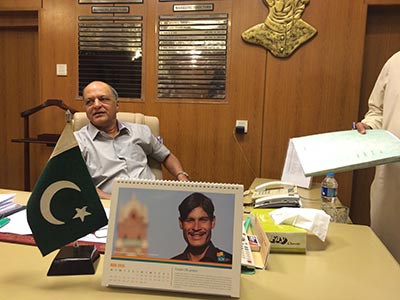
Syed Hashim Raza Zaidi, the reluctant MD
Indeed, the water board is perennially plugging leaks. At the MD’s office they are following up on a broken pump. Syed Hashim Raza Zaidi is a well-worn bureaucrat who has occupied posts as diverse as the Chaghi deputy commissioner when Pakistan did its nuclear testing. (“I didn’t go see the location,” he says. “If you go, you see. And there is a 0.001 possibility you might tell someone.”) He has been working as the secretary to the Ombudsman but has been given the additional charge of the water board chief. It has been three days into the job but he is already working the phones. Engineers briskly walk in and out with files, problems to be solved, orders to be taken. Zaidi brooks no small talk and gets straight to the point. The phone beeps like an ICU monitor. He picks it up, says what he needs to say in a handful of sentences and puts the phone down with a crack.
“Two pumps are broken,” he says. “Locally we are trying to repair one. One has been sent to Lasbela. It’s a huge thing to fix it. Manufacturing ended 50 years ago, parts are not available. If one malfunctions, repairing it is a huge task.” The propellers that push the water through broke. “They are so old, wo jharne lage. They are bigger than this table,” he says waving his hand across the expanse of his desk that can seat a small dinner party. Imagine if even one of the nine propellers is broken, they won’t pump water to the city.
It is a nightmare job. When asked about it, Zaidi likes to quote Che Guevara, who roughly translated, once said that his job was to fight for the land, not run it. Zaidi liberally borrows from the freedom fighter and applies these words to himself: “This is not my job.” Being the MD of the water board is possibly one of the worst postings a bureaucrat can get (if you are honest), which is small wonder that Zaidi laments the exit of Qutbuddin Shaikh, the man he replaced upon retirement, as he feels qualified engineers should be running the show and be left in their seats long enough to see their policies through. “One step is to put a good officer in my place,” Zaidi says. “Someone who they guarantee will be here for a few years. Shaikh Qutub was a good person but he retired.” A strong MD would naturally be a prerequisite to manage the utility but interference also weakens the system. “We get separate orders from the Commissioner,” says one senior staffer who did not want to be named because of the pressure they are under. “We get another order from the governor. We have a meeting with the MPAs and they will sing their own song. The corps commander. Where do we go?” In a draft report prepared for court, one KW&SB engineer made a quiet little note, saying that Aslam Sanjrani, a top-ranking bureaucrat, intervened to prevent an FIR being registered against him for running an illegal hydrant off the Haleji conduit.
A look at the tenure of every water board MD. Source: KW&SB
Bad budgets and bribes
Karachi can certainly expect the water crisis to get worse each year unless someone fixes the water board. “It is a miracle they get water to you given the budgets within which they work,” says Arif Hasan, who is familiar with the inner workings of the KW&SB as he once sat on the board. While the whole city is cursing the KW&SB, Hasan is one of the few people who argues that it is not fair to entirely blame its staff given that so many extenuating factors have contributed to the situation.
When asked if he thinks that the hydrants were just closed to create an artificial shortage to jack up tanker prices, he says: “The government is making people suffer so that its officials and politicians can make money… this is correct and it is not so correct,” he cautions. “It is not as simple as this.” For him, we are all suffering today because the water board has not become a financially self-reliant institution. “The original planning was absolutely correct,” he says. “No matter how much you swear at them now… every area had a bulk meter.”Indeed, they are still there and up to 20 years ago, the meter used to register how much water each area was to receive. Some experts and water board officials have argued that meters can’t work when there isn’t enough pressure in the lines, but the director at the major textile company says they have Kent meters acquired from Denso Hall market area which work when water comes. “They have a small turbine inside that measures water by each revolution,” he explains. There shouldn’t be any reason why they can’t be installed on bulk supply lines, he says, estimating that they would cost at the most Rs400,000.
Technology is eclipsed by human management when it comes to using meters to measure how much water is taken by tankers from Karachi’s hydrants.
The problem appears to be that the meter readings and payments aren’t directly managed by the water board’s revenue department but by its tanker cell. “We [only] receive the pay orders,” says Muhammad Aslam Khan, the deputy managing director for revenue. “But we can’t tell whether they are jaez or na jaez.” His point is corroborated by executive engineer Nadeem Ahmed of the water meter division, who says, “We don’t have billing. That is with the hydrant cell.”
The authorities recently announced that meters were being installed on hydrants and indeed they have, says Ahmed. The bulk supply lines already had meters: nine at Dhabjei, three at Pipri, three at Hub, three at the COD Hill Filter Plant and one at the federal trunk main. The new ones for hydrants are being fitted with seals so the staff can be able to tell if they have been tampered with.
A meter is a squat round thing. The water board buys the mechanical British Kent ones through Minerwa Traders and also has the sensor ones produced by Zurich-based ABB company.
The new ones are being fitted with seals at a shed at COD Hill Filter Plant, a green oasis tucked away behind National Stadium. Assistant executive engineer Khalid Meraj holds up the ABB electromagnetic prop meter which consists of a pole fitted with a sensor at the end. “It is inserted into a pipe and gives the readings,” he explains. They measure in the cubic meter which is equal to 1,000 litres. So you have to convert by multiplying by 220 to turn it into gallons. The chunkier Kent meters have propellers inside which rotate when water passes through and the revolutions calculate the amount of water passing through.
These meters come in the same diameter as the pipes. So for a 6-inch pipe you fit a 6-inch meter and so on. Some experts have suggested that meters don’t work because the water doesn’t pass through with the same pressure and flow all the time. But this isn’t true. The meter will record the water passing through when it does. Others have argued that they are too expensive but that isn’t the case. They come for Rs60,000 and can go up to Rs400,000 for the larger ones with sensors.
The only concern that the meter staff have is theft and damage to the new meters they are installing because it has happened in the pass. “Now we will build a chamber for them,” says Meraj. But he doesn’t seem entirely sure this measure and the application of security seals will work. After all, there are too many powerful forces at work to ensure the amount of water measured from the hydrants is always skewed.
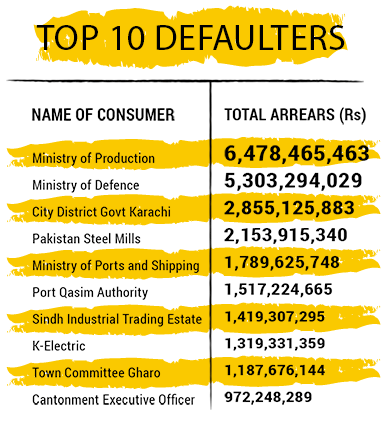 A list of the top ten defaulters according to total arrears.
A list of the top ten defaulters according to total arrears.
Source: KW&SB
But today, the KW&SB budgets are in the red because it isn’t able to earn for the water service it supplies. “How do you want a broke institution to work?” asks Arif Hasan. They do not get enough for repairs and maintenance, which is why Zaidi is struggling to fix the propeller for a pump as old as Partition. Their backup diesel generators don’t work, so when the power goes out (either because of faulty cables or an unpaid bill) the water rushes back into the rising main and it takes hours to get the system back up and running again.
This financial hollowing out over decades led to cheap alternatives. “When there aren’t enough funds, [an institution] becomes desperate. There is helplessness and that leads to corruption,” Arif Hasan says. It started when people said they would give the KW&SB staff money to get their work done. “People started try to replace things with jugardh and this became institutionalised over time.” KW&SB was also trying to cater to a city growing at breakneck speed. So instead of increasing the water supply and adding pumping stations, which is how it is done in the rest of the world, its existing network of pipes were just extended. “The pipes ran till Surjani Town, then they added on and added on and stretched to Khuda ki Basti,” says Hasan. “A politician comes and promises [people water]. Well, he isn’t getting them more water from Dhabeji or the Indus; he is just extending these lines.” That wrecks the system. This is why it takes ten million rupees to bribe the KW&SB to reopen your illegal hydrant.
The water board needs to hire a PR manager. “People will have water 360 days of the year but if one day they have an event and there isn’t water they will say they never get water,” says Muhammad Aslam Khan, who manages the finances at the MD’s office. The political pressure on the KWSB these days is immense. But most of all it appears to be an image problem. The optics are so bad that newspaper reports skewer the KWSB for a water shortage in Gulshan-e-Iqbal which is the most “water rich” neighbourhood in Karachi, according to meter cell executive engineer Nadeem Ahmed. It’s all about this and the political clout, he says. For example, Bath Island, which has the cast iron pipes from the time of the British needs a rehaul but it is the nearby Hijrat Colony, Tekri and other informal settlements that have been given new pipes in 1988, 2002, 2006, 2009. “It’s because they are voters,” Ahmed explains.
No one knows better how much the bribery and corruption have spread in the system than the deputy managing director of the water board’s finances. Mairajuddin sits in his office with the air-conditioning blasting away, collar open at the neck and calculator at his wrist. He has been secretly trimming fat from the water board’s spending budget. Each year the budget is based on how much they assume they will earn and have to spend. But as the year passes it becomes clearer that their revenue isn’t going to be what they expected (because people don’t pay their bills) and the utility’s expenses will grow. So the budget is revised downwards. The problem is that bureaucrats still overproject and inflate the numbers when planning the next budget. For his part, though, Mairajuddin has been deflating it. “Last year I cut one billion quietly and they found out later and made a noise,” he says, adding that he knows the psychology of managing money at KW&SB: “If they have money they will spend it.” He is also aware that corrupt staffers always skim off a certain percentage from the top of any spending. So he reduced how much they could take. “It has to be a realistic budget,” he says.
 The charts above aim to highlight how KW&SB's reliance on revenue generated from water and sewerage billing diminished after the Sindh government decided to restore the power subsidy to KW&SB. Source: KW&SB
The charts above aim to highlight how KW&SB's reliance on revenue generated from water and sewerage billing diminished after the Sindh government decided to restore the power subsidy to KW&SB. Source: KW&SB
But these small fixes by one bureacrat sitting in an office can hardly turn the water board’s finances around when only 30% of the city pays its bills. Whatever money that does come its way has to be prioritised and paying 13,000 salaries is high on the agenda. The rest of the budget is spent on fighting fires. Repairs and maintenance will always get a larger share than new development. The money is spent on fixing leaky pipes but not new ones. “It is easy to fund what is working rather than new stuff,” explains Mairajuddin. This is not an institution that is in any position to prepare for the future.
This is why no money can usually be spent on laying new networks in the water-starved neighbourhoods of Karachi. The crisis has prompted the Sindh government to start work on the KIV which is supposed to bring more water from the Indus River but this will take at least three years and the project has been stuck for a few years over financing. Firefighting is the KW&SB’s default operating mode which is why it allows the quick fixes of hydrants and tankers. “The KW&SB has completely abrogated its responsibility to supply water itself,” says non-profit Shehri-CBE, which was tasked by the Sindh High Court in 2010 to assess if hydrants were even needed. “It has approached this perennial problem by supplying water through by opening and tendering 21 hydrants. These private hydrant operators now rule the water distribution network and KW&SB has been reduced in its role as bulk supplier.”
One theory is that the hydrants were shut just so that higher bribes could be extracted to reopen them. “If they kept eating the egg… they were after the chicken,” quips Huzoor Ahmed of the tanker association, who says the KW&SB staff help with the digging and theft for illegal connections. He goes as far as to say that officers will bill on their own for connections to factories that are fed illegally from sources along the Malir naddi. “Water board ke paas pani he, imaan nahi he,” he adds.
Private panic
No one is more panicked about the water crisis than Karachi’s industry, especially textile factories.
They have been eyeing the future with trepidation and have been trying to assess the direction supply is headed. “Nobody really knows today what the shortage will be like,” says the director of a one of Karachi’s largest textile mills that exports globally to major brands. “Some people say it will be three times, some four times.” Many industrialists are not waiting for the government to take the initiative and are investing in their own recycling plants. They know that when push comes to shove, the government may be forced to divert precious water away from factories and into homes if rioting becomes more wide scale. But this would be a Catch-22, says the director. “If industry shuts down, people will be jobless,” he says. But if people are on the streets, then water will be taken away from industry.
 The KW&SB's proposed operational expenses are almost three times the revised figure of last year, but that's primarily because of the Rs5 billion subsidy from the Sindh government to help the board pay its electricity bill. Source: KW&SB
The KW&SB's proposed operational expenses are almost three times the revised figure of last year, but that's primarily because of the Rs5 billion subsidy from the Sindh government to help the board pay its electricity bill. Source: KW&SB
Textiles, especially denim, use an extraordinary amount of water. A small to medium unit that makes 50,000 to 100,000 meters of cloth a day needs between 300,000 to 500,000 gallons of water daily. (1,000 gallons is 3,800 large mineral water bottles). The only long-term solution is to recycle for which many factories are buying land or contemplating it. You can set up a recycling plant on two acres of land, the director says. Ideally, an industrial area would have community recycling plants in which several factories invested. But this is far from practical as fighting would break out over who would have more right to the recycled water depending on how much they invested and whether their infrastructure or drains would support it. Individually, though, factories can each aim to recycle 60% of the water they release and drain 40% of it. This would cost the same as buying tankers. Recycling all your water is extremely expensive and only one company is doing this in Sindh at least. “Many people have gone to see this recycling plant,” adds the director. They have zero waste because they extract all their water and the sludge that is left over is so concentrated that they make bricks from it which can be used for low-cost housing.
But recycling water is not something that textile factories will have to do just because the shortage will grow in the future. They need to meet the standards of their international buyers such as Ikea which make it mandatory for them to recycle or they stand to lose their contracts. It is this push from the outside to meet these standards combined with government incentives and the looming shortages that will force factories to recycle more. Right now there is a 15% import duty on recycling plant machinery that needs to go down and the government could consider special borrowing rates as well to sweeten the deal.
How the system and our thinking needs to change
The tragedy is that Karachi is a city that lies at the mouth of one of the greatest rivers of the world. “Any scarcity of water [given Karachi’s location] is inevitably artificial, i.e. mediated by human technology and institutions,” says Dr Daanish Mustafa, referring to the shortage. “I am somewhat indifferent to the question of whether it is artificial or natural.” It is the system that has to be fixed. “Having a city depend upon tankers for water is utter nonsense and speaks to the abject state failure here,” he goes on to say. “But any attempt to control, curtail, rationalize or realign the tanker-based supply system is inevitably going to cause major disruptions, in the absence of any intervention to address the dysfunctional parts of the entire supply system—of which there are many.”
This is why Arif Hasan advises that a big review of KW&SB is in order. We must understand its problems, especially those related to operations and maintenance for which you need money and expertise. There needs to a system why which people pay their bills and a 10-year plan needs to be worked out. All the experts stress that a long term plan is needed because Karachi will simply not get any more water from Hub and would need more water from the Indus River to feed the city. There needs to be an equitable supply of water to all—not through tankers whose price is not driven by supply and demand but rather by oligopolistic and monopolistic pricing, as Dr Daanish Mustafa puts it. “I have never seen such a naked use of power to appropriate water from the powerless and send it on to the powerful as I have in Karachi,” he says. “And there is nothing that the state is doing to protect the weak against the strong, in fact quite the opposite.”
There will come a time when you may have 20,000 rupees to pay for a tanker but there won’t be any water to pay for
Data & mapping: Khurram Siddiqui
Art: Aamir Khan
Development: Irfan Ansari, Sawant Shah
Coordination: Ali Haider
With thanks to: Isfandiyar Shaheen and Aisha Arif of Dawood Hercules Corporation for interpreting the KW&SB budget. Ali Ousat and Faisal Hussain, bureau chief of ExpressNews in Karachi, for assistance in reporting.
How do people have absolutely disgusting imported water-hogging plants in their gardens in Defence and then devote 90% of their domestic water use to them and then millions have to pay 10 to 50 times more per unit of (saline) water just to drink in the same city?
-Dr Daanish Mustafa
Geographer and water expert, King’s College London

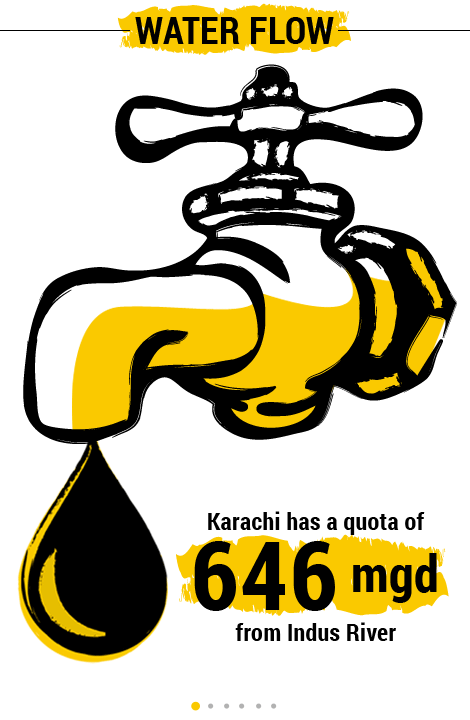
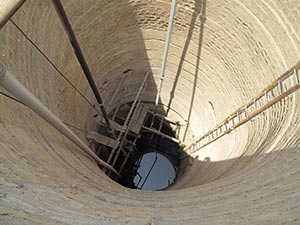
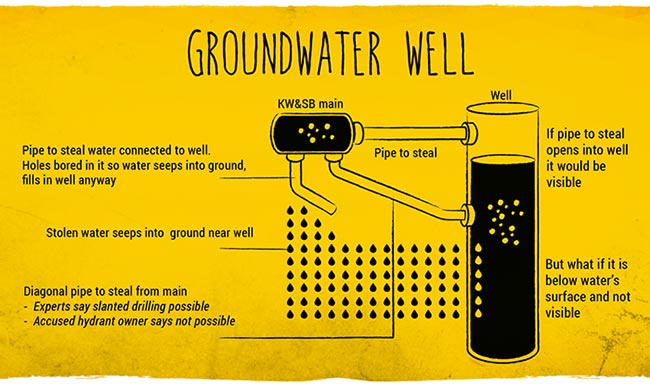
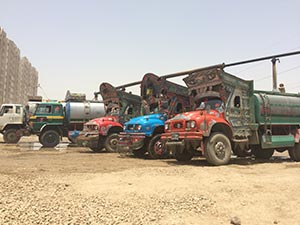
 A breakdown of KW&SB's expenditure. Since these are revised figures, this is the closest we can get the actual figures. The revision is carried out towards the end of the fiscal year. The category called 'Establishment' is mainly composed of the salaries and benefits to the 13,000 or so employees of the board. Source: KW&SB
A breakdown of KW&SB's expenditure. Since these are revised figures, this is the closest we can get the actual figures. The revision is carried out towards the end of the fiscal year. The category called 'Establishment' is mainly composed of the salaries and benefits to the 13,000 or so employees of the board. Source: KW&SB




 A list of the top ten defaulters according to total arrears.
A list of the top ten defaulters according to total arrears.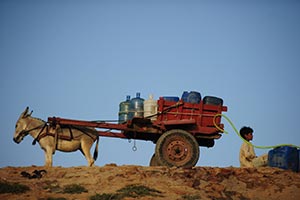
 The charts above aim to highlight how KW&SB's reliance on revenue generated from water and sewerage billing diminished after the Sindh government decided to restore the power subsidy to KW&SB. Source: KW&SB
The charts above aim to highlight how KW&SB's reliance on revenue generated from water and sewerage billing diminished after the Sindh government decided to restore the power subsidy to KW&SB. Source: KW&SB
 The KW&SB's proposed operational expenses are almost three times the revised figure of last year, but that's primarily because of the Rs5 billion subsidy from the Sindh government to help the board pay its electricity bill. Source: KW&SB
The KW&SB's proposed operational expenses are almost three times the revised figure of last year, but that's primarily because of the Rs5 billion subsidy from the Sindh government to help the board pay its electricity bill. Source: KW&SB
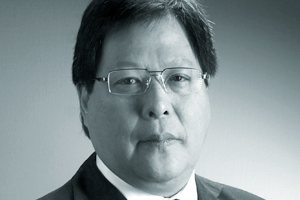
Water crisis! What water crisis? A crisis in human intelligence maybe?
Just like everything in life, when we are accustomed to things in abundance at throw away prices we take them for granted. This is a commentary on urban water use in many cities in a rapidly urbanising world
Nicholas You
Montorgiali, Italy
Why do cities have to wait till their backs are against the wall to begin to react? Having worked in many major metropolises around the world, it is clear to me that the syndrome is ubiquitous. We waste and mismanage water because for prolonged periods of time it was abundant. This abundance was achieved through engineering feats of the last century coupled with the foresight of decision makers at the time to build excess capacity. This, in turn, led public authorities worldwide to charge little for water, a policy that many justified by the health externalities of water provision in urban areas.
Previous attempts at raising sufficient funds from water tariffs to renew infrastructure, render the entire system more efficient and equitable, and to establish demand management have encountered political opposition almost everywhere. After all it was, and still is, politically more convenient to subsidise a utility—especially when it is a public monopoly—than to reform tariffs and quotas. This has led over time to gross inefficiencies, unjustifiable losses in transmission as well as wasteful behaviour and a misplaced sense of entitlement on behalf of water users and consumers.
The short-term solution is simple. Use transparent and accountable market mechanisms to regulate supply and demand to wean users off cheap water. Progressive tariffs should be politically acceptable everywhere with daily minimum requirements billed at cost (or below cost) and anything above billed at exponentially higher rates in direct proportion with use. This would preserve the health and other externalities of “affordable” water and penalize wasteful or luxurious use to the point just before being painful for the very well to do. Such a system already exists in Pakistan and is being practiced by the authorities in Bhalwal in the Punjab (as reported by Ali Salman in The Express Tribune in March ‘Many Pakistanis are using 10 times more water than world average).
But making water a commodity is far from sufficient. What is required for a truly sustainable urban water system is nothing less than a fundamental revisit of how we think water. Most large metropolises around the world transport water from quite large distances whether horizontally, vertically or both. In extreme cases a lot of energy is used to desalinate water. The water is then filtered and treated with chemicals to make it drinkable. It is then piped to standpipes, fountains and faucets through an extensive network. The ultimate benefit of all this energy, chemicals and infrastructure is to provide 5 litres (1.3 gallons) of drinking quality water that each person needs each day to drink and cook with in order to remain healthy. What becomes of the 53.7 remaining gallons of the 55 gallons of water that WHO recommends as the daily minimum? It ends up in our toilets and becomes an even more expensive to treat commodity known as sewerage. This is not because we use that much water to flush our toilets. It is because all the water we use to wash ourselves, our clothes and our dishes is mixed with what we flush down the toilet, making all used water in our cities the quality of toilet flush.
Clearly we need to begin to see the folly of how we are using the most precious planetary resource and begin to think reuse and recycling.
Nicholas You is a veteran urban and intergovernmental expert, architect-planner and organizer of international city activities. He is the chairman of the organising committee of the Global Mayors’ Forum, the chairman of the UN-Habitat World Urban Campaign Steering Committee, the Assurance Group for Urban Infrastructure of the World Business Council for Sustainable Development, and of the Urban Strategy Council for GDF-Suez. He also serves as member of the board of Citiscope, the Huairou Commission, the Joslyn Institute for Sustainable Communities and the Guangzhou Institute for Urban Innovation